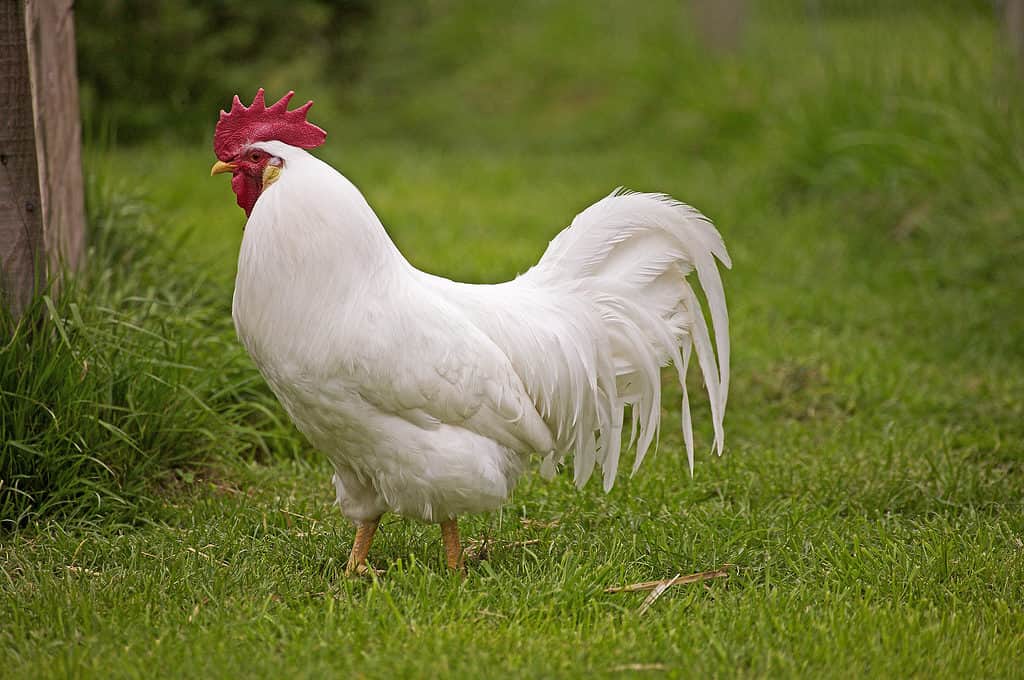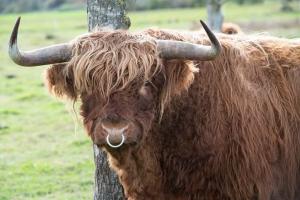Leghorn Hen vs Rooster: What Are The Differences?
Leghorn chickens are a pretty popular breed in the poultry world. While both leghorn hand and roosters are the same breed, they have many different characteristics and behaviors. When raising these animals, it’s important to understand the differences between a leghorn hen vs. rooster.
Of course, everyone knows hens lay eggs, and roosters do not. However, these two genders have different behaviors and care needs, which are important to consider when taking care of them. This knowledge helps poultry optimize the productivity of their flock.
1. Physical Characteristics

©slowmotiongli/Shutterstock.com
Leghorn Hen
Leghorn hens tend to have a smaller, lighter build than the roosters. They weigh between 4 to 4.5 pounds, which makes them lighter than most. The hens usually have a consistent feather color pattern – often white or cream-colored. They have a sleek appearance with tight feathers.
Leghorn hens typically have a small, single comb atop their heads. This comb is usually red in color and less pronounced than that of the rooster. Their wattles (the fleshy, pendulous growths under their beak) are also smaller and less prominent.
Leghorn Rooster
Leghorn roosters are larger and heavier than hens. They are usually bred for meat and reproduction. Their larger body size is between 5.5 to 6 pounds or more. Their color patterns vary, and they often have more colorful and striking plumage than hens. Some popular varieties include white, brown, and black.
Leghorn roosters typically have a larger, prominent comb compared to hens. Their comb is very brightly colored, making it a distinguishing feature.
Roosters also have larger and more noticeable wattles compared to hens. These fleshy protuberances can become quite vivid in color, especially when the rooster is healthy and in prime condition.
Behavior and Temperament
Leghorn Hen
Leghorn hens have great egg-laying qualities. They are prolific layers, producing large white eggs at a remarkable rate. Leghorn hens tend to be consistent in their egg production and can lay up to 280 to 320 eggs per year.
They are very social and relatively non-aggressive, especially compared to other chicken breeds. Therefore, they can coexist peacefully with other hens in the flock. They are not known for their desire to sit on and hatch eggs. Therefore, they aren’t likely to become broody.
Leghorn Rooster
A leghorn rooster’s job is to protect and lead the flock. They’re known for their alertness and will often keep an eye out for potential threats, alerting the chickens to predators and other threats.
Roosters, including leghorns, can be territorial and may be protective of their hens. They may engage in minor fights with other roosters to establish dominance.
Leghorn roosters may also engage in courtship displays like tidbitting, where they offer food to hens. Aggressive behavior towards hens should be discouraged, and aggressive roosters are often culled.
Like many roosters, leghorn roosts will crow at the break of dawn. While this is a charming aspect to some, others find it less charming. They may not be appreciated by neighbors in suburban areas.
Purpose and Utility
Leghorn Hen
Leghorn hens are prized for their egg production. That is what they were bred for, so they do a very good job of producing quality eggs. They’re considered one of the best egg-laying breeds, consistently producing large white eggs. They’re very popular for backyard flocks for this reason.
They are not typically raised for meat because of their smaller size. They are also very lean compared to other chicken breeds, which may make them not as tasty. However, some individuals still consume their meat, especially if they end up with an overabundance of chickens.
Leghorn Rooster
Leghorn roosters have a limited utility for modern backyard flocks. They are not commonly used for meat due to their smaller size. Furthermore, they are often aggressive towards other roosters, making it nearly impossible to keep more than a couple in a flock.
Therefore, these birds are primarily used for reproduction.
Breeding Considerations
Most people have both hens and roosters for breeding purposes. Because roosters are aggressive and you can only keep a few, it’s important to choose the best roosters for breeding. There isn’t a one-size-fits-all answer to this, though.
Firstly, it’s important to prevent inbreeding, which helps maintain the health and vigor of the birds. Otherwise, birds will be more likely to inherit recessive, harmful traits. You should identify and prioritize the specific traits you want in your hens. This may include things like egg production, temperament, and color.
If the primary goal is to produce hens that lay a high volume of eggs, selecting Leghorn hens with a strong track record of prolific egg-laying is essential. Likewise, choosing roosters from egg-producing lines can help perpetuate this trait. While roosters don’t produce eggs, their genetics do affect the hens they produce.
While it isn’t necessarily practical, many breeders also want a specific plumage color for their flock. In this case, keeping roosters that you find aesthetically pleasing may be important. Furthermore, there are some breed standards that you may choose to uphold in case you want to sell your birds.
Keep detailed records of your breeding program to prevent unintentional inbreeding. You should also rotate your birds regularly and introduce new genetic material to the flock.
Misidentification
Both hens and roosters are regularly misidentified as other chicken breeds. For instance, Rhode Island Red hens are often confused with Longhorn hens. Both breeds have red combs and wattles, which can make them look similar. However, there are also several differences.
Longhorn hens are often smaller with a sleeker appearance, and they lay white eggs. Rhode Island Red hens are larger with a robust build, and they usually lay brown eggs.
Another confusion may arise between Leghorns and Sussex hens, which can have similar white plumage. Still, Sussex hens are typically heavier, have a more rounded appearance, and lay brown eggs.
Plymouth Rock hens are often mistaken for Leghorns due to their white-and-black striped plumage. But, again, Leghorns are much smaller.
Common Misconceptions
Leghorns are often said to be aggressive, especially roosters. Some individual roosters are assertive, especially during breeding season. Their behavior can vary widely from individual to individual, as well. Proper handling and socialization can often mitigate aggressive tendencies.
They also tend to crow excessively, but this isn’t true for all roosters. They tend to crow just as much as other roosters.
It’s often believed that Leghorn roosters are incompatible with other chicken breeds in mixed flocks. While they can be protective and territorial, proper flock management and introduction procedures can help mitigate conflicts within the flock.
Summary of Leghorn Hen vs. Rooster
| Characteristic | Leghorn Hen | Leghorn Rooster |
|---|---|---|
| Size and Weight | Smaller, around 4-4.5 pounds | Larger, around 5.5-6 pounds |
| Feather Color and Pattern | Typically white or cream-colored, sleek feathers | Varied colors, often more colorful plumage |
| Comb Type | Small single comb, usually red | Larger, more prominent single comb, often brightly colored |
| Wattles | Smaller and less prominent | Larger and more noticeable |
| Egg Production | Prolific layers, white eggs, up to 280-320 eggs per year | None |
| Broodiness | Not prone | None |
| Behavior | Social and non-aggressive | Can be protective, territorial, and vocal |
| Crowing Habits | Does not crow | Known for crowing |









